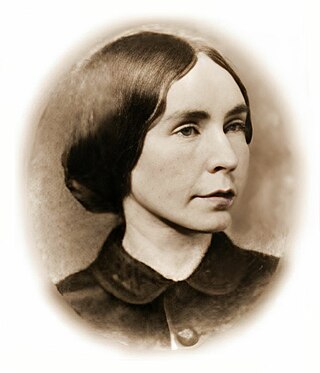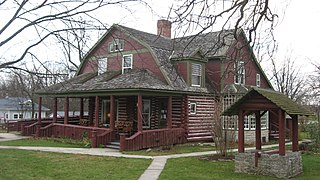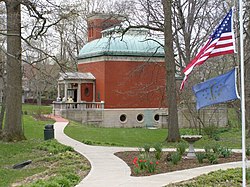Ben-Hur or Ben Hur may refer to:

Lewis Wallace was an American lawyer, Union general in the American Civil War, governor of New Mexico Territory, politician, diplomat, artist, and author from Indiana. Among his novels and biographies, Wallace is best known for his historical adventure story, Ben-Hur: A Tale of the Christ (1880), a bestselling novel that has been called "the most influential Christian book of the nineteenth century."

Crawfordsville is a city in Montgomery County in west central Indiana, United States, 49 miles (79 km) west by northwest of Indianapolis. As of the 2020 census, the city had a population of 16,306. The city is the county seat of Montgomery County, the only chartered city and the largest populated place in the county. It is the principal city of the Crawfordsville, IN Micropolitan Statistical Area, which encompasses all of Montgomery County. The city is also part of the Indianapolis–Carmel–Muncie, IN Combined Statistical Area.

Ben-Hur: A Tale of the Christ is a novel by Lew Wallace, published by Harper and Brothers on November 12, 1880, and considered "the most influential Christian book of the nineteenth century". It became a best-selling American novel, surpassing Harriet Beecher Stowe's Uncle Tom's Cabin (1852) in sales. The book also inspired other novels with biblical settings and was adapted for the stage and motion picture productions.

Ben-Hur: A Tale of the Christ is a 1925 American silent epic adventure-drama film directed by Fred Niblo and written by June Mathis based on the 1880 novel Ben-Hur: A Tale of the Christ by General Lew Wallace. Starring Ramon Novarro as the title character, the film is the first feature-length adaptation of the novel and second overall, following the 1907 short.

Ben Hur is a 1907 American silent drama film set in ancient Rome, the first screen adaptation of Lew Wallace's popular 1880 novel Ben-Hur: A Tale of the Christ. Co-directed by Sidney Olcott and Frank Oakes Rose, this "photoplay" was produced by the Kalem Company of New York City, and its scenes, including the climactic chariot race, were filmed in the city's borough of Brooklyn.

The Palace of the Governors is an adobe structure built in the Territorial Style of Pueblo architecture on Palace Avenue in Santa Fe, New Mexico. Located within the Santa Fe Historic District along the Santa Fe Plaza between Lincoln and Washington avenues, it has served as the seat of government for New Mexico for centuries, having been established as the capitol building of Nuevo México in 1610.
Lew Wallace High School was a four-year (9-12) public high school of the Gary Community School Corporation in Gary, Indiana, United States.

Ben-Hur was an 1899 theatrical adaptation of the novel Ben-Hur: A Tale of the Christ (1880) by Lew Wallace. The story was dramatized by William W. Young and produced by Marc Klaw and A. L. Erlanger. The stage production was notable for its elaborate use of spectacle, including live horses for the famous chariot race. The hippodrama had six acts with incidental music written by American composer Edgar Stillman Kelley. The stage production opened at the Broadway Theater in New York City on November 29, 1899, and became a hit Broadway show. Traveling versions of the production, including a national tour that ran for twenty-one years, played in the United States, Great Britain, and Australia. By the end of its run in April 1920, the play had been seen by more than twenty million people and earned over $10 million at the box office. There have been other stage adaptations of Wallace's novel, as well as several motion picture versions.

Susan Arnold Elston Wallace was an American author and poet from Crawfordsville, Indiana. In addition to writing travel articles for several American magazines and newspapers, Wallace published six books, five of which contain collected essays from her travels in the New Mexico Territory, Europe, and the Middle East in the 1880s: The Land of the Pueblos (1888), The Storied Sea (1883), The Repose in Egypt: A Medley (1888), Along the Bosphorus, and Other Sketches (1898), and The City of the King: What the Child Jesus Saw and Heard (1903). She was also the wife of Lew Wallace, a lawyer, American Civil War general, politician, author and diplomat. Susan completed the manuscript of Lew Wallace's two-volume autobiography following his death in 1905, with the assistance of Mary Hannah Krout, another Crawfordsville author. Wallace died in Crawfordsville in 1907.

The Catlin Covered Bridge is a single span Burr Arch truss covered bridge structure that was built by Clark McDaniel in 1907.

The Thorpe Ford Covered Bridge is northeast of Rosedale, Indiana. The single span Burr Arch Truss covered bridge structure was built by Joseph A. Britton in 1912.

The Lane Place was the home of Sen. Henry S. Lane and Joanna Lane (1826-1914). It is located at 212 South Water Street in Crawfordsville, Indiana. Helen Elston Smith, the Lanes' niece, inherited the house after Joanna's death. She willed the house and its contents to the Montgomery County Historical Society on February 26, 1931. 85%-90% of all of the furnishings are either original to the house or belonged to the Elston Family. The house has been a museum since 1931 even though Helen continued to live in the home until the mid-1930s.

Sycamore Dale is a 19th-century Greek Revival plantation house overlooking the South Branch Potomac River southwest of Romney, West Virginia. Sycamore Dale is one of several historic estates along South Branch River Road. It was listed on the National Register of Historic Places on December 2, 1980.

The Golden Age of Indiana Literature is a period from 1880 to 1920 when many nationally and internationally acclaimed literary works were created by natives of the state of Indiana. During this time, many of the United States' most popular authors came from Indiana. Maurice Thompson, George Ade, Booth Tarkington, Theodore Dreiser, Edward Eggleston, Frank McKinney Hubbard, George Barr McCutcheon, Meredith Nicholson, Gene Stratton Porter, Lew Wallace, and James Whitcomb Riley were foremost among the Hoosier authors.
The Tribe of Ben-Hur was a fraternal organization based on the novel Ben-Hur: A Tale of the Christ by Lew Wallace. In 1930 it became the Ben-Hur Life Association.

Gene Stratton-Porter Cabin, , known as the Limberlost Cabin and the Limberlost State Historic Site, was the former home of Gene Stratton Porter, a noted Indiana author who lived in the home from 1895 to 1913. The two-story, fourteen-room log cabin is located near the Limberlost Swamp on the outskirts of Geneva in Adams County, Indiana. Stratton-Porter designed the Queen Anne-style rustic home with the help of an architect. It was listed on the National Register of Historic Places in 1974.

The Blacherne is a historic apartment building located at Indianapolis, Indiana. It was built in 1895, and is a large seven-story, 6 bay by 15 bay, red pressed brick building on a limestone foundation. It features two circular projecting bays at the corners and a semicircular limestone Romanesque Revival style entry portal.

Lew Wallace is a statue by Andrew O'Connor that has been produced in both marble and bronze versions.
Kalem Co. v. Harper Bros., 222 U.S. 55 (1911), was a United States Supreme Court case in which the Court held producing a motion picture based on a dramatic work can be copyright infringement. The producer of the motion picture is liable even they are not the exhibitor. This does not extend to a restriction of the dramatic work's ideas; it is a recognition of the author's monopoly powers granted by Congress.



















